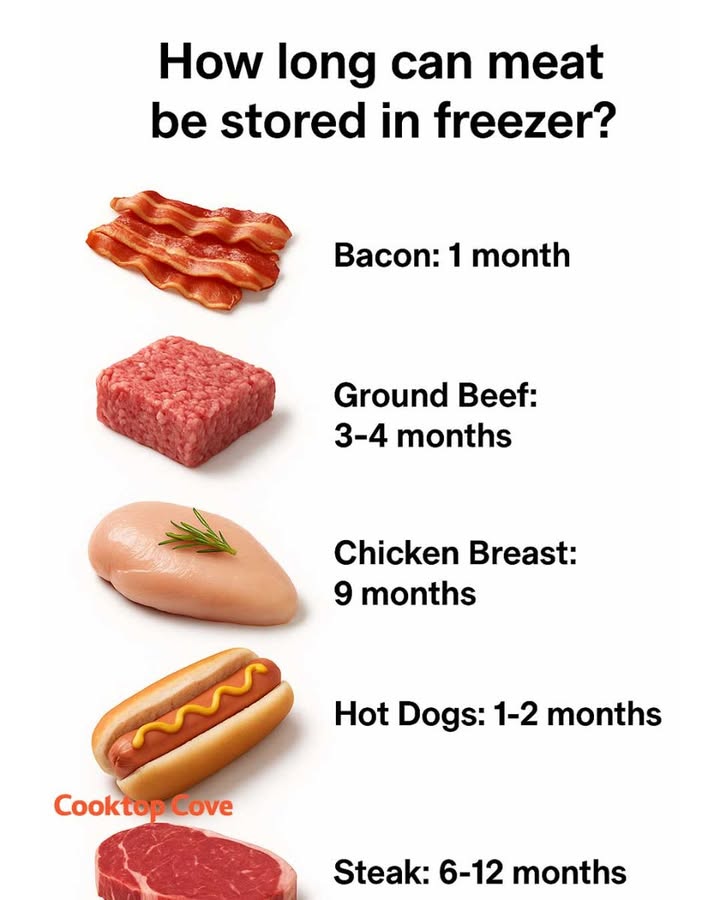Freezing meat is one of the most effective ways to preserve its freshness and extend its shelf life. But not all meats respond the same way to freezer storage. Knowing how long each type of meat can safely stay frozen can help you get the most out of your freezer while ensuring your meals still taste great. By using the right storage techniques, you can prevent freezer burn, retain nutrients, and reduce waste in your kitchen. Whether you’re stocking up on everyday staples like beef and chicken or storing more unique meats like duck and venison, understanding the proper freezing duration is key to maintaining quality.

1. Beef: How Long Is Too Long?
Beef is freezer-friendly and can stay fresh for quite a while when stored correctly. Ground beef should be used within 3 to 4 months for peak quality, while steaks and roasts can be frozen for 6 to 12 months. To maximize freshness, make sure the meat is tightly sealed—vacuum sealing is ideal—and label it with the date you froze it. Air is the enemy here, so use airtight packaging and remove as much air as possible to prevent freezer burn.
2. Chicken: A Household Staple
Chicken is a go-to protein in most American homes. Whole chickens can stay in the freezer for up to 12 months, while parts like wings, thighs, and breasts are best consumed within 9 months. Ground chicken should be used in 3 to 4 months. To keep your chicken tender and juicy, wrap it in plastic or foil before placing it in a freezer-safe bag. Freezing in individual portions makes it easier to defrost only what you need.
3. Pork: Freezing for Flavor
Pork chops and roasts freeze well for up to 4 to 6 months, while ground pork is best used within 3 to 4 months. High-fat items like bacon and sausage have a shorter freezer life of about 1 to 2 months. To avoid texture and flavor loss, double wrap pork in plastic and foil or use vacuum-sealed bags. Always label your packages to stay organized and ensure you’re using the oldest products first.
4. Lamb: Storage Tips for Premium Cuts
Lamb has a rich flavor that holds up well in the freezer. Chops and roasts can be kept frozen for 6 to 9 months, while ground lamb should be used within 3 to 4 months. Store lamb at 0°F or below in airtight packaging, and for best results, vacuum seal it. Marking the freezing date will help ensure you cook it at its best.
5. Turkey: Not Just for Thanksgiving
A whole turkey can be frozen for up to a year, while turkey parts like thighs or breasts are best consumed within 9 months. Ground turkey should be used in 3 to 4 months. It’s smart to wrap the meat tightly and use freezer bags to lock out air. If storing a large bird, consider cutting it into parts before freezing for easier handling and faster thawing.
6. Fish: Handle with Care
Fish is delicate, and its freezer lifespan depends on fat content. Fatty varieties like salmon and mackerel can be stored for 2 to 3 months, while lean fish like cod or haddock last up to 6 months. Wrap fish in moisture-proof material, such as vacuum-sealed plastic, to prevent freezer burn and keep flavor intact. Freezing fish at 0°F or lower is crucial to safety and freshness.
7. Shellfish: Texture Matters
Shellfish like shrimp, lobster, and crab require careful freezing to maintain their texture. Raw shrimp can last up to 6 months, while cooked shellfish should be eaten within 3 months. For best results, freeze shellfish in airtight containers or bags, or in a saltwater brine to preserve texture. Always freeze at or below 0°F and label clearly with the date.
8. Venison: Storing Game Meat
Venison is lean and stores well when properly packaged. Steaks and roasts can last 9 to 12 months in the freezer, while ground venison should be used within 3 to 4 months. Use vacuum sealing or double wrapping to preserve flavor and texture. Date-label everything and keep the freezer at a consistent 0°F or below.
9. Duck: Rich Flavor, Careful Freezing
Whole ducks can remain frozen for up to 6 months, while parts like duck breasts and legs are best used within 3 to 4 months. As with other meats, airtight packaging or vacuum sealing is ideal to lock in flavor and avoid ice crystals. Mark your packaging with the date so you can track freshness easily.
10. Sausage: Fresh vs. Cooked
Sausages are delicious but don’t last as long in the freezer. Fresh sausage should be used within 1 to 2 months, while cooked sausage can stretch to 2 to 3 months. Wrap them securely and vacuum seal if possible. Keep your freezer at 0°F and rotate older items forward to avoid forgetting them.
11. Thawing: Do It the Right Way
How you thaw frozen meat matters just as much as how you freeze it. The safest method is to thaw in the refrigerator, allowing meat to defrost slowly. This can take hours or even days depending on the size. If you’re short on time, use the cold water method—submerge the meat in cold water and change it every 30 minutes. Never thaw meat at room temperature, as this increases the risk of harmful bacteria. If you need to refreeze thawed meat, be sure to cook it first.
12. Does Freezing Affect Nutritional Value?
Freezing meat helps preserve its nutrients, but you might lose a bit of moisture, which can slightly alter texture. Protein, vitamins, and minerals stay mostly intact, making frozen meat just as nutritious as fresh. For best results, freeze meat at peak freshness and always use appropriate wrapping to protect against freezer burn.
By following these meat-specific freezing guidelines and storing everything at a consistent 0°F or lower, you can enjoy flavorful, safe meals while cutting back on waste and saving money. Happy freezing!





